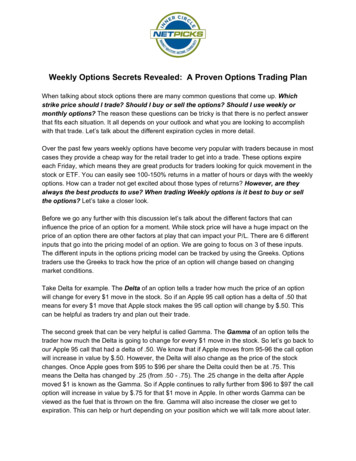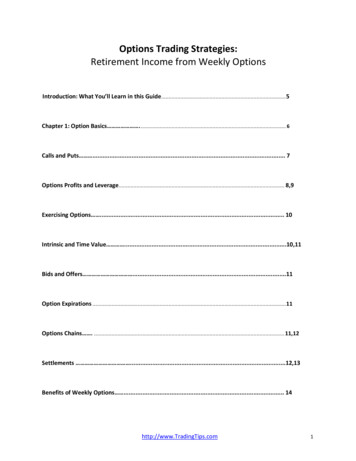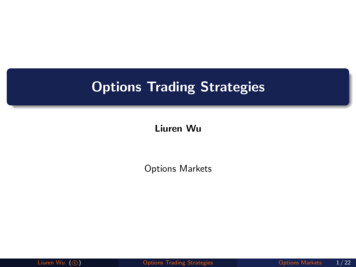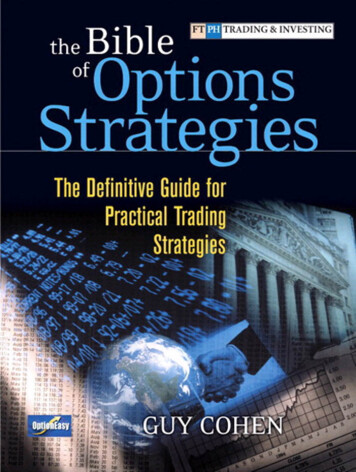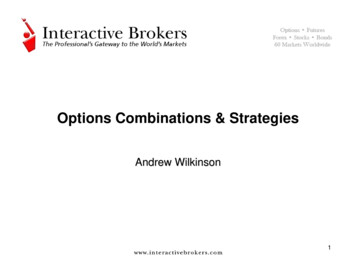
Transcription
OptionsTradingStrategies for aVolatileMarket
Five SimpleOptionsTradingStrategies forConsistentProfits in aVolatile Market
Table Of ContentsIntroductionChapter 1 – OverviewChapter 2 – Basics of VolatileOption StrategiesChapter 3 – Account TradingLevelsChapter 4 – Long Straddle
Chapter 5 – Strap StraddleChapter 6 – Long StrangleChapter 7 – Strip StrangleChapter 8 – The Long GutChapter 9 – Final NotesConclusion
IntroductionI want to thank you verymuch and congratulate youfor downloading the book,Options Trading Strategiesfor a Volatile Market–FiveSimple Options TradingStrategies for ConsistentProfits in a Volatile MarketThe goal of this book is tohelp people who are already
familiarwithoptionterminology and the basics ofhow the options marketworks.In this book, you’ll discoverthe five best options tradingstrategies for a volatilemarket. For each strategy,you’ll learn how it works, thebest times to use it, the riskand reward dynamics, andyou’ll be taken step-by-stepthrough complete examples.
Thanksagainfordownloading this book, Ihope you enjoy it!
Legal Copyright 2014 Zantrio,LLC. All rights reserved.All rights reserved. This bookcontains material protectedunder U.S. copyright laws.Any unauthorized reprint oruse of this material isprohibited. No part of thisbook may be reproduced ortransmitted in any form or by
any means, electronic ormechanical,includingphotocopying, recording, orby any information storageand retrieval system withoutexpress written permissionfrom Zantrio, LLC.Risk DisclaimerTrading in any financialmarket involves substantialrisk of loss and is not suitablefor all investors. Any style of
trading in any marketcondition is extremely riskyand can result in substantialfinancial losses in a veryshort period of time. There isconsiderable exposure to riskin any transaction includingbut not limited to, thepotentialforchangingpolitical and/or economicconditionsthatmaysubstantially affect the priceor liquidity of a trade.
Trading is a challenging andpotentiallyprofitableopportunity for those who areeducated and experienced intrading. Before deciding toparticipate in the markets,you should carefully consideryour objectives, level ofexperience and risk appetite.Most importantly, do NOTinvest money you cannotafford to lose. Objective,experience, risk of loss,leverage,creditworthiness,
limited regulatory protection,market volatility that maysubstantially affect the priceor liquidity of a trade,communication failure, etc.could put you at risk for theloss of some or all of yourcapital and/or assets. Thepossibility exists that youcould sustain a total loss ofinitial funds and be requiredto deposit additional funds tomaintain your position.
We are not offering to buy orsell and of the financialinstruments mentioned in anyservice we offer and we arenot representing ourselves asaregisteredinvestmentadvisor or broker dealer.We do not guarantee orrepresent that members actinguponanysuggestionmentioned or discussed inany of the services we offer,will result in a profit. All
decisions to act upon anysuggestions made in anyservice we offer is the soleresponsibility of the member.We will not be heldresponsible or liable tomembers or any other partiesfor losses that may besustainedwhiletrading.YOUR trading and financialactions taken are solely 100%YOURdecisionandresponsibility.
We may hold positions invarious financial instrumentsmentioned in any of theservices we offer and areunder no obligation todisclose when a position wasacquired, the amount ofposition held or when aposition is closed.We are not an investmentadvisor, and we do notprovide investing advice. Allcontent provided is for
information purposes ORD TO LOSE. WE DINGADVICE.YOUARECOMPLETELY100%RESPONSIBLE FOR ANYFINANCIAL/INVESTING/TR
DECISION YOU MAKE.WE ARE NOT LIABLEWHATSOEVER IN ANYWAY, SHAPE OR FORMFOR ANY ACTION YOUTAKE.BYTRADING/INVESTING,YOU RUN THE RISK OFLOSINGEVERYTHINGYOU OWN. YOU KEEPYOUR GAINS, YOU PAYFOR YOUR LOSSES. ENDOF STORY.
Earnings DisclaimerThe products and servicessold by Zantrio, LLC are notto be interpreted as a promiseor guarantee of earnings. Allcontent provided is forinformation purposes only.Any and all forward-lookingstatements on our website orin any of our products areintended to express ouropinion of the earnings
potential that some peoplemay achieve. We make noguarantees that you willachieve any results from theideasandtechniquescontained on our website orin our products.To the extent that weincluded any case studies ortestimonials on our website orin any of our products, youcan assume that none of thesestories in any way represent
the "average" or "typical"customer experience.In fact, as with any product orservice, we know that somepeople will purchase ourproducts but never use themat all, and therefore will getno results whatsoever. Youshould therefore assume thatyou will obtain no resultswith this material.YOU FULLY AGREE AND
UNDERSTANDTHATCOMPANYISNOTRESPONSIBLE FOR YOURSUCCESS OR FAILUREANDMAKESNOREPRESENTATIONS ORWARRANTIES OF ANYKINDWHATSOEVERTHAT OUR R YOU. Zantrio, LLC ISNOT AN INVESTMENT
ADVISOR AND DOES NOTPROVIDE INVESTMENTADVICE. ALL CONTENTISPROVIDEDFORINFORMATIONPURPOSES ONLY.
Bonus: Download theFree Trading ToolkitGet instant access to freecheatsheets, workbooks andguides to help you become aprofitabletraderorinvestor.As a special thanks fordownloading this book, we'veput together a toolkit of
exclusiveincluding resources,
Click to Download
the Free TradingToolkitorvisit:www.zantrio.com/kind
ChapterOverview1–This guide is to help peoplewho are already familiar withoption terminology and thebasics of how the optionsmarket work. It is designed togive you an overview of themain strategies for usingoptions when the marketconditions are volatile.
Making money in a volatilemarket is risky as a volatilemarket means that prices canrise and fall dramatically.This is significantly differentto a bearish or bullish marketas your strategies have to beable to profit when the priceof the underlying asset movesby a significant amount ineither direction, and not justin one.The reason that options are
held in such high regard byprofessional traders is thatyou can set up strategies thatallow you to make a profitregardless of whether theprice of the underlying assetmoves up or down, as long asit does so by a significantamount.Large pricemovements are not the onlykind of volatility that youneed to consider when talkingabout a volatile optionmarkets though.
As an experienced optiontrader you should already befamiliar with the Greeks, andknow that the Vega shows theimplied volatility of an optioncontract.A change inimplied volatility can have adramatic effect on the cost orpremium of the option, andyou always need to be awareof implied volatility for thisreason. Therefore a volatileoption market can be whenprices jump quickly or when
the impliedincreasing.volatilityisIt is important to note thatalthough implied volatilityshould increase when there isa major news event affectingthe underlying asset, anddecrease when the market isquiet.It is possible forimplied volatility to changewithout any obvious reason.This is due to a shift in themarket perception of what the
implied volatility should be,rather than from any factualcause. Implied volatility willincrease with demand for aparticularoption,anddecrease if demand is low.
Chapter 2 – Basics ofVolatileOptionStrategiesThe basic theory behindconstructing an effectivestrategy for a volatile marketis to take advantage of duodirectional profits. What thismean in its simplest form isthat you are setting up
positions that are made up oftwo parts. The first part is toset up a trade that will gainmore than it will lose whenthe price of the underlyingassets rises, and the secondpart does the opposite. Thismeans that it will gain morefrom the rapid decline in thevalue of an option than it willlose.The simplest version of this isto use a combination of long
calls and long puts in thehope that the change in theprice of the option due tohigh volatility will push oneof these two trades intoenough profit to cover thecost of the one that is going tobe out of the money. Morecomplexstrategiesforvolatile markets work bycombining bullish and bearishoption strategies in a way thatwill accomplish much thesame thing. When setting up
a volatile option strategy thething that you want to lookfor is a high Gamma valuewith a neutral or almostneutral Delta value.A good time to implement avolatile option strategy iswhen there is a potentialincrease in the impliedvolatility on the market, evenif the prices have not yetstarted to move. This will setyou up for success at the
lowest possible cost, and willoccur when the strategy thatyouareconsideringimplementing has a positiveVega value. Just by having apositive Vega value ifeverything else stays thesame, the position you haveselected should make a profit.Evaluate your volatile optionstrategies in periods beforeearnings release statements,or other key financial
information about a companyor the market as a whole.Volatility across the markettends to increase during theseperiods. As soon as you seethat implied volatility hasstopped increasing and hasreached its peak, then youshould close the strategy.Thereisavolatilitymeasurement index calledVIX that a lot of traders useto track implied volatility anddecide when volatility is
increasing or has peaked.
Chapter 3 – AccountTrading LevelsIf is important to understandthe account trading levels thatapply for option tradingaccounts.Some of thestrategies in this guide requirehigher trading levels thanothers. Often referred to asyour ‘trading’ or ‘approval’level, it is set by your broker
based on your net worth, andyour level of experience intrading options.In most cases, when you firstopen an option account youwill be given a level of 1.You will need a higher levelthan that to implement thetrading strategies in thisguide, so you need to contactyour broker and discuss whatyou are looking to do, andwhat he needs from you in
order to get the approval youneed.Level 1 allows you to tradecovered calls and protectedputs. This means that youneed to own the underlyingasset and is not much use fortrading options. At level 2you are able to buy call andput options. You are not ableto use debit spread strategiesuntil your approval level hasreached level 3. You cannot
utilize credit option strategiesyet, as this is at level 4.Level 4 will also allow you totrade short butterfly spreads.The reason that the approvallevel is so high is that creditstrategies are complex andrequire a lot of experience toknow exactly what yourprofit or loss can be. Level 5is the highest level andusuallyreservedforinstitutional traders as you
can write call and put optionswithoutowningtheunderlying asset. This isextremely dangerous as youare exposed to a very highrisk.
Chapter 4 – LongStraddleThis is one of the moststraightforward of all of thevolatile option strategies, andallows you to make a profitwhether the value of youroption contracts increases ordecreases, as long as it doesso significantly. This meansthat the best time to employ a
Long Straddle is when youexpect the value of anunderlying asset to suddenlymove either up or down veryquickly. The usual reasonwhy the value of anunderlying asset will do thisis often a major news event.Setting up a long straddle isvery simple and can beexecuted very quickly. Whatyou need to do is to executean at the money call and an at
the money put at the sametime, for the same underlyingasset, expiring at the sametime, and as far away as youcan get. The potential profitis unlimited as if the value ofthe underlying asst risessharply, then you will make aprofit on the call less the costof the two premiums.Similarly if the value of theunderlying asset sharplydrops in value you will makeunlimited potential profit on
the put that you purchased,less the cost of the twopremiums.
ExampleAn example would be if youexpected the price of ABCCompany is going tosuddenly move significantlybut are unsure whether it willbe up or down and the currentvalue of the stock is at 25.You would want to buy a calloption with a strike price ofas close to 25 as you canfind, and a put option with the
same strike price. If youthink the movement is goingto occur within the nextmonth then you would buyboth of these options with thesame expiry and at least onemonth to left.Assuming the premium oneach at the money option isapproximately the same, say 1 for this example, then yourtotal cost to set up this tradewill be 1 1 2 times
100 shares in the optioncontract so 200. If you arecorrect and ABC companygets great news and the pricerises from 25 a share to 30a share, then you will make aprofit of 5 * 100 shares 500 less the premium cost of 200 300. If the price haddropped by the same amountfrom 25 to 20 then yourprofit would be the same.In addition to these two profit
alternative there is a thirdone, where the impliedvolatility of the underlyingasset rises, while you areholding the two options eventhough the price of theunderlying asset does notchange, then the value of bothof your option positions willstill rise, and you will make aprofit if you close them whenthe implied volatility peaks.If none of these situationsoccur before expiry you will
lose both premium payments.
Chapter 5 – StrapStraddleYou should use a StrapSaddle when you expect thevalue of underlying asset tomove suddenly and that themove is more likely to be upthan down. To set it up, youbuy more call than put
options.Considering youbelieve that the value is morelikely to rise than drop,
Trading Strategies for Consistent Profits in a Volatile Market. Table Of Contents Introduction Chapter 1 – Overview Chapter 2 – Basics of Volatile Option Strategies Chapter 3 – Account Trading Levels Chapter 4 – Long Straddle. Chapter 5 – Strap Straddle Chapter 6 – Long Strangle Chapter 7 – Strip Strangle Chapter 8 – The Long Gut Chapter 9 – Final Notes Conclusion. Introducti

